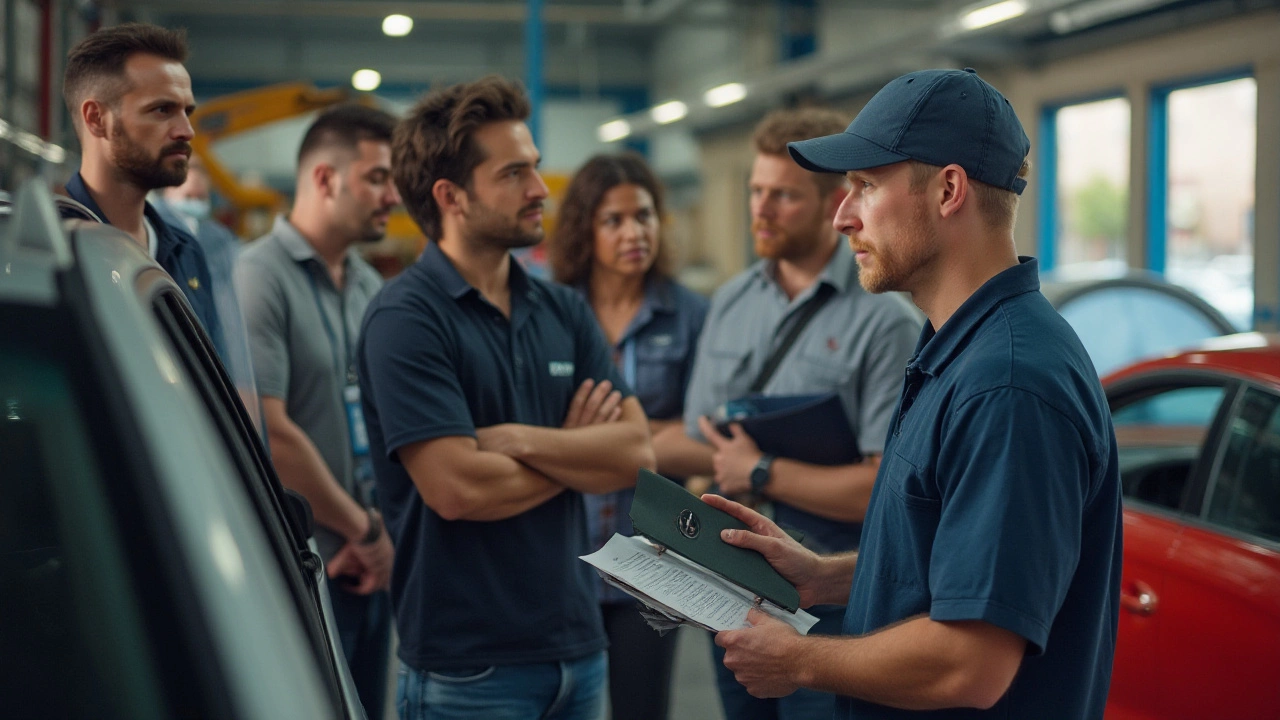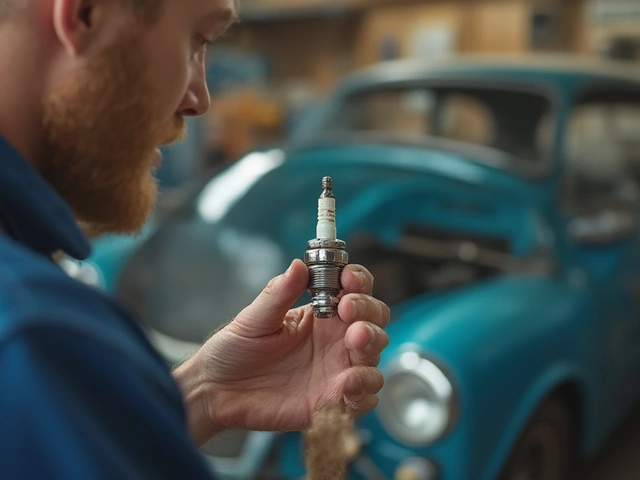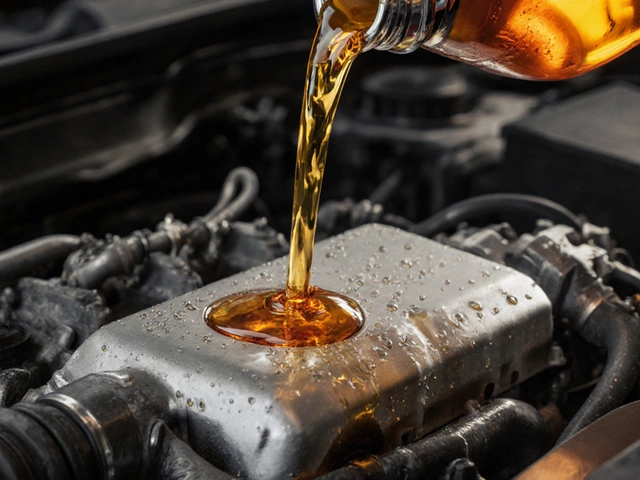When it comes to your car’s safety, ensuring your brake system is in tip-top shape is non-negotiable. Brake pads are a crucial component, and knowing when they need a swap can save you more than just money—it can save lives. While they might seem elusive with their hiding spot behind the wheel, brake pads have a way of speaking up when they demand your attention.
Imagine cruising down the M5 and noticing an odd squeal every time you softly press the brake pedal. Or perhaps, you sense a vibration that wasn't there last week. These changes hint at brake pads reaching the end of their life. Understanding these signals is pivotal, as these hidden saviors keep your drives smooth and, most importantly, safe.
- Recognizing the Warning Signs
- Why Brake Pads Wear Out
- A Timeline for Brake Pad Longevity
- Consequences of Neglecting Replacement
- Tips for Maintaining Brake Health
Recognizing the Warning Signs
Every journey begins with a first step, and when it comes to ensuring your vehicle safety, it’s crucial to listen to what your brake pads are trying to tell you. One of the most tell-tale signs is a high-pitched squeal every time you apply the brakes. This noise often arises from a small metal indicator that lightly touches the rotor and is designed to alert you before the pads wear down completely. It's not just about the noise; it’s a call for action, imploring you to pay attention before the situation becomes dire. Alongside this, a grinding sound can emerge, signaling that your brake pads might have worn way past their useful life, exposing the metal beneath, which then grates against the rotors. This can lead to more extensive and expensive repairs if neglected.
Another red flag that might catch your attention is a vibration or pulsating feel in the brake pedal, often during a stop. Such occurrences may not only indicate worn pads but could also hint at warped rotors caused by prolonged brake use or neglect. The sensation isn’t just uncomfortable; it can significantly affect stopping performance, making it a critical warning sign. It's prudent to act swiftly when faced with this issue, as the brake system's health heavily relies on dealing with such abnormalities promptly.
You might also start noticing that your car pulls to one side when you brake. This could be a sign that the brake pad on one side is thinner than on the other, or there might be impurities within the brake fluid. In essence, anything that disrupts the symmetry of your brake system’s pressure can result in a veer to one side. Such changes not only affect how the vehicle feels but can also compromise safety, requiring immediate attention.
A lowered brake pedal also serves as a significant indicator that it’s time for a brake check. If the pedal almost reaches the floor before engaging the brakes, the pads might be too thin for comfort. It echoes a deeper need for repair or replacement, reminding you to prioritize maintenance. What’s essential here is recognizing the subtleties of such warning signs and acknowledging them before they morph into larger problems.
Finally, it’s vital to keep an eye on the brake light on your dashboard. While it doesn’t necessarily mean worn brake pads, it could indicate an issue with the system that requires attention. Regular vehicle inspections and maintenance routines help in catching warning signs early. As the saying goes, 'Prevention is better than cure,' and this couldn’t be more appropriate when considering the integral nature of a vehicle’s brake system. The vigilance you maintain not only extends the life of your brake pads but also ensures a safer and more secure driving experience.
“Listening to what your vehicle communicates is key to preventing costly repairs and ensuring safety on the road. A well-maintained brake system is the foundation of a vehicle that lasts.” - Jane Doe, a renowned automotive expert.
Why Brake Pads Wear Out
Brake pads are some of those car parts that seem to vanish into thin air over time. Although we can't see them working day in and day out, the friction they endure when slowing down your vehicle is nothing short of relentless. This friction is what ultimately causes them to wear out. Imagine the sheer physical force they experience, especially in urban settings where stop-and-go traffic is a daily norm. It's no wonder they demand replacement more frequently than many other car components.
Over time, the surface of the brake pads becomes thinner as they are worn down by the rotor with each braking event. Temperature plays a significant role in wear, too. High levels of heat build-up between pads and rotors, particularly during aggressive driving or while descending long hills, can lead to increased wear and, in extreme scenarios, brake fade. Did you know that every time you press down your brake pedal, the pads are exposed to temperature spikes of hundreds of degrees Celsius?
The Impact of Driving Habits
Our driving habits have much to do with how fast brake pads may expire. An individual who frequently slams on the brakes will find that their brake pads diminish more rapidly than someone who slows down gradually. This is because sudden braking creates more heat and friction, accelerating wear and tear. In contrast, a driver with the foresight of slowing the car before rounding corners or approaching red lights lengthens the life of their pads.
Interestingly, the materials used in brake pads can also affect their longevity. Semi-metallic pads, known for their durability, can be harsh on rotors, while organic pads, though gentler on rotors, may not last as long. Here's a small insight into brake pad materials:
- Organic: Quiet operation, typically softer but wear out faster.
- Semi-metallic: Harder, more durable, but tend to be noisier and abrasive to rotors.
- Ceramic: Long-lasting and quiet, but generally pricier than other options.
Each type has its merits, and the choice ultimately boils down to the driver's needs and the conditions under which they typically drive.
"It is integral for car owners to understand that brake pads wear differently based on the vehicle type and driving environment," states Roland Weeden, a brake system analysis expert based in Coventry.
In short, keeping an eye on driving habits, understanding the car you handle, and appreciating the physics at play can extend the life of your brake pads substantially. That way, you'll be well-prepared when it's time to swap out your brake pads, keeping your car on the road safely and efficiently.

A Timeline for Brake Pad Longevity
Understanding the lifespan of your brake pads is as crucial as recognizing the signs they need changing. Several factors influence how long brake pads last, including the material they're made from, your driving style, and the type of vehicle you own. On average, brake pads can expect to last between 30,000 to 70,000 miles. However, this range can differ widely; aggressive driving or frequent stop-and-go traffic can significantly shorten this span, while gentler driving might extend it.
Metallic brake pads are known for their longevity compared to organic or semi-metallic alternatives, but they can also produce more noise and generate higher dust levels. On the other hand, ceramic pads, often lauded for their quiet performance and lower dust generation, may not last as long under high-stress conditions. According to a 2023 survey by the Automobile Association, ceramic pads typically offer smoother and quieter braking experiences but might come with a premium price tag due to their composition.
The type of vehicle, be it a compact car or a large SUV, also plays a significant role in brake pad longevity. Larger vehicles often require more durable pads due to the increased weight and stopping power needed. Many drivers might not be aware that brake pads wear out faster in cities than in rural areas, due to the constant stop-and-go nature of urban driving. The frequency and intensity of braking maneuvers affect the brake replacement cycle, which makes regular maintenance and checks essential.
Factors Impacting Wear and Tear
Driving habits are another crucial aspect. Gentle drivers who engage in smooth, anticipatory braking will find their brake pads lasting significantly longer. Meanwhile, those with abrupt stopping styles or who often drive on hills might face quicker wear. Interestingly enough, a study by Brake Manufacturers Council suggests that 25% of drivers underestimate their brake pad wear, leading to delayed replacements.
"Investing time in understanding how different factors affect brake pad longevity can lead to safer driving and more efficient maintenance," noted David Gill, an expert in automotive repair.
For fleet vehicles, following a strict maintenance routine is vital to ensuring vehicle safety. Fleet managers often keep logs of maintenance history and set specific mileage intervals for inspections. Such practices not only extend the life of the brake pads but also prevent unforeseen brake-related accidents. A regular check on pad thickness is an actionable step that any vehicle owner can undertake, easily facilitated during routine servicing.
Consequences of Neglecting Replacement
Overlooking the need to replace worn-out brake pads can lead to a multitude of issues, each one more risky than the next. At first, the signs might seem innocuous—a bit of squealing here, some extra force needed there. However, those sounds and sensations are your car's way of gently nudging you to pay attention. If ignored, what starts as a minor inconvenience can quickly escalate into a full-blown safety hazard. Compromised brake performance is not something to be taken lightly. Every time you hit the roads, those pads are crucial for stopping your vehicle smoothly and effectively. When they wear too thin, they put additional strain on other components of your braking system, like the rotors, leading to costly repairs.
Modern brake pads are specifically engineered to warn drivers with distinctive noises when they get too thin, courtesy of indicator wear strips embedded within. Yet, not every vehicle has this feature, and even then, some drivers might mistakenly attribute these sounds to road conditions or other vehicle noises. Ignoring the noise could result in the metal of the braking system grinding against the metal of the brakes themselves. This is not just disruptive and unpleasant but can severely damage your brake rotors, requiring expensive repairs that could have been easily avoided with timely brake pad replacement.
Moreover, there's the undeniable danger of a reduced braking distance. A worn-out brake pad doesn't generate the necessary friction needed to bring your vehicle to a halt as promptly as it should. When you’re traveling at 70 miles per hour—the typical speed on a motorway—the difference between stopping in an emergency and an accident can hinge on a fraction of a second. It's unnerving to realize that poor brake maintenance could be the invisible factor in this critical situation. Studies from automotive safety experts consistently emphasize the pivotal role brake pads play in ensuring vehicle control. "Regular checks and timely replacements aren't just maintenance tips; they're a commitment to road safety," insists auto safety advocate Graham Edmunds.
Apart from immediate risks, ignoring brake pad replacement can also lead to longer-term consequences for the car. The unintentional strain placed on the vehicle's braking system can subtly undermine the overall health of the vehicle, affecting everything from fuel efficiency to tire wear. Eventually, this leads to unexpected breakdowns or the need for a complete braking system overhaul, which is both time-consuming and expensive. By staying on top of brake pad maintenance, you not only ensure your safety but also keep your vehicle running optimally, maintaining its value and performance over the years.

Tips for Maintaining Brake Health
When it comes to ensuring your vehicle's brakes remain reliable, a little care goes a long way. For starters, it's vital to remember the importance of regular inspections. Even if everything seems fine, having a professional take a look under the proverbial hood every so often can help catch potential problems before they become costly repairs. Routine checks can spot wear and tear, preventing unexpected failures that could jeopardize your vehicle safety.
Beyond inspections, consider your driving habits. Aggressive drivers who frequently accelerate and slam on the brakes tend to wear out their brake pads much faster. By anticipating stops and applying brakes gently, you can extend the life of your brake pads. It's a simple adjustment, but the savings can be significant. Additionally, leaving space between you and the car in front allows for a more gradual stop, reducing the demand on your brakes.
Every part of your car interacts with others, and brake pads are no exception. Keeping an eye on your tires is another way to ensure brake efficiency. Properly inflated tires with an even tread can make a world of difference. Uneven tire wear means uneven braking, which in turn stresses your brake pads. Regular tire rotations and alignments keep your car balanced, helping your brake replacement interval stretch further than you might expect.
Consider the environment in which you most often drive. If you frequently find yourself driving in hilly or mountainous regions, recognize that the extra braking required could lead to faster deterioration of brake components. In these settings, using engine braking by downshifting can take some of the burdens off your brakes. It's an overlooked technique but can be a game-changer in maintaining brake health over prolonged periods.
Investing in quality parts is another straightforward way to extend the longevity of your braking system. Although tempting, budget brake pads might cost you more in the long haul with quicker wear and subsequent replacements. Opting for car maintenance parts from reputable brands ensures longer performance and often comes with guarantees that provide peace of mind. As a seasoned mechanic once said,
"Cheap parts are too expensive."It’s a sentiment echoed by many professionals across the industry.
Finally, a clean brake system works far more efficiently than a dirty one. Dirt and debris can accumulate in and around your brakes over time, leading to reduced performance and even damage. Regular cleaning avoids sediment build-up that could impede the effectiveness of your brakes. Using non-corrosive spray and being gentle during the process helps maintain both the appearance and function of your brake components, covering an often overlooked aspect of brake health.






